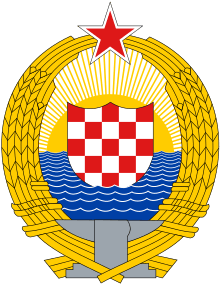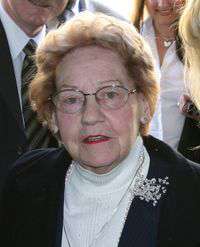Croatian Spring
The Croatian Spring (Croatian: Hrvatsko proljeće, also called masovni pokret or MASPOK, for "mass movement") was a cultural and political movement that emerged from the League of Communists of Croatia in the late 1960s which opposed the unitarization and called for economic, cultural and political reforms in SFR Yugoslavia including higher autonomy and more self governing rights for SR Croatia within Yugoslavia. In 1971, the Yugoslav authorities suppressed the movement by force.


History
Background
The 1960s and 1970s in Croatia were marked by general emancipation from the Stalinist policies employed in Yugoslavia after World War II.[1] Despite significant conservative resistance, the country underwent major reforms, including economic reforms that in 1964/1965 started to introduce a market economy, and the democratization of the League of Communists of Yugoslavia between 1966 and 1969 which led to giving a bigger role to the Leagues of Communists of each individual republic and province.[1][2]
The 1960s also saw the rise of social sciences in the country. Political science and sociology were introduced to universities against the resistance of communist hardliners. After studying abroad, in Western countries, social scientists introduced critical thought to their home universities, which gradually made them centers of opposition thought and criticism of the regime, especially in Ljubljana, Zagreb and Belgrade.[3]
After being a target of significant animosity and suppression by the regime in the 1940s and the 1950s, the Catholic Church's status in Croatia also improved as a consequence of the democratization of the country, particularly in the wake of the Second Vatican Council (1962–65) and the establishment of diplomatic relations between Vatican and Yugoslavia in 1966. By the mid-1960s, public religious events were permitted again, and the relationship between the Church and the state was that of mutual tolerance. The Catholic Church in Croatia, however, did not take an active role in the national movement and political events associated with it, even if its leadership was privately sympathetic with the reformists.[4]
Political demands
The removal of Aleksandar Ranković, a strong proponent of a centralized Yugoslavia, in 1966 marked an opening for groups seeking greater devolution. A group of 130 influential Croatian poets and linguists, 80 of whom were Communists, published a Declaration on the Status and Name of the Croatian Standard Language in March 1967.[5][6] After 1968 the patriotic goals of that document morphed into a generic Croatian movement for more rights for Croatia which received grassroots support, especially amongst many student organizations which actively started to voice their support for the cause.
A younger generation of reformer politicians in the republics' Communist Party organizations gave the movement momentum in an effort to overcome the Party monopoly and to expand various civil rights.[1] The right to take pride in one's history was a prominently featured topic. This irritated President Josip Broz Tito's communist government. Among the issues raised was the practice by the Yugoslav People's Army to send people on mandatory military service into other republics rather than leaving them in their home republic.
There were also attempts to bring the notion of including Herzegovina into Croatia to the attention of the authorities (similar to the Banovina of Croatia that existed within the Kingdom of Yugoslavia from 1939 to 1941), but this was far from anything that the movement leaders were proposing. In fact, such red herrings were often used to denounce the demands related to decentralization and autonomy as expansionist and ultimately separatist.
Economic issues
In the early days of the movement, the Croatian political leadership voiced demands for a democratization and decentralization of the economy, which would have allowed the republic to keep more of the profits made within Croatia, as opposed to using the income from tourism and from emigrants to avert economic ruin.[5][6]
The economic problems in Yugoslavia at the time contributed to increased economic emigration, and these economic problems particularly affected Croatia, despite the fact it had been the source of the majority of the income from tourism and that 37% of all Yugoslav emigrant workers had come from Croatia.[5][6]
Croatian economist Vladimir Veselica became known during this period for writing about the how Croatia had failed to profit from the foreign currency that had entered Yugoslavia through Croatia, using a disproportionately small amount of it.[7] An independent National Bank of Croatia would have allowed for a fairer distribution of profits. By waiving the right to use the federal bank of Yugoslavia, the republic would also have to waive its right to use the federal fund for underdeveloped regions.
At the 10th session of the Central Committee of the League of Communists of Croatia held on 15 January 1970, Savka Dabčević-Kučar presented a quality paper on what she described as petty rhetoric about how Croatia was getting harmed in Yugoslavia.[8] Croatian 1968 GDP per capita was 25% above the national average, among other positive statistics.[8] Croatia used only 16.5% of the money from the federal solidarity fund between 1965 and 1970, while the Yugoslav government used 46.6% mostly for the least developed region Kosovo and Metohija. Concerns were also raised about the monopoly of the Yugoslav Investment Bank and the Bank for Foreign Trade from Belgrade on all foreign investments and trade.[5][6] Yugoslavia's 1971-75 Five-Year Plan was to be adopted in July 1970 but was postponed due to inter-republic conflict, high inflation and administrative reorganization.[9] In the midst of the movement, the Federal Executive Council froze all prices in November 1971 for a four-month period.[10]
Public unrest
The movement organized demonstrations in 1971 and thousands of Zagreb students publicly protested.
Three Croatian linguists, Stjepan Babić, Božidar Finka and Milan Moguš, published a spelling and grammar textbook in September 1971 called Hrvatski pravopis (Croatian Orthography), rather than the Srpskohrvatski (Serbo-Croatian). It was summarily banned, and virtually all copies were destroyed. However, a surviving copy found its way to London where it was reprinted and published in 1972.[11]
The Yugoslav leadership interpreted the whole affair as a restoration of Croatian nationalism, dismissed the movement as chauvinistic and had the police brutally suppress the demonstrators. In 1971, Soviet Union leadership applied additional pressure on Marshall Tito directly by Leonid Brezhnev and indirectly by its ambassadors to Yugoslavia, to assert control of the Communist party within Yugoslavia, ostensibly adhering to the Brezhnev Doctrine.[12]
After the calls to the student strike, in December 1971 Tito persuaded to resign some unreliable, in his view, public figures like Savka Dabčević-Kučar, Miko Tripalo and Dragutin Haramija and make a sweep in Croatian communist party and local administration. According to Tripalo's estimate, two thousand people were criminally prosecuted in Croatia in 1972 and 1973 for participation in these events.[13] Among those arrested at this time were future president of Croatia Franjo Tuđman and dissident journalist Bruno Bušić. Others arrested and convicted include student activists Dražen Budiša, Ivan Zvonimir Čičak, Ante Paradžik and Goran Dodig, and Matica hrvatska members Vlado Gotovac, Marko Veselica, Šime Đodan, Jozo Ivičević and Hrvoje Šošić.[14][15] In 1972, more than 25,000 people were expelled from the League of Communists of Croatia.[16]
The social and political conservative forces engaged in a repression that prevented the final reforms that would have made Yugoslavia a true federation of sovereign republics and provinces, instead reducing both the Yugoslav political concept and its nomenklatura to a kind of "real socialism" that lacked potential.[17]
Aftermath
In 1974, a new federal constitution was ratified that gave more autonomy to the individual republics, thereby basically fulfilling some of the goals of the Croatian Spring 1971 movement.
The downfall of the Croatian Spring marked the beginning of a period known as the "Croatian silence" (Hrvatska šutnja), in which Croatian politicians refrained from taking a firmer stance in federal politics, aligning themselves with the League of Communists of Yugoslavia.[18][19] This period would last until 1989.[19]
Legacy
Several student leaders from the Croatian Spring later emerged as influential political figures after the collapse of communism. Franjo Tuđman became the first President of Croatia, Šime Đodan became a member of parliament and a one time Minister of Defence, Ivan Zvonimir Čičak became the leader of the Croatian Helsinki Committee for Human Rights. Dražen Budiša became the leader of the Croatian Social Liberal Party. Savka Dabčević-Kučar, Miko Tripalo, and Dragutin Haramija became founding members of the new Croatian People's Party.
The fourth edition of the Babić-Finka-Moguš Hrvatski pravopis is used today as a standard definition of the Croatian language, though other Croatian spelling and grammar manuals have also been published.
References
- CPSR 2012, p. 8.
- Spehnjak & Cipek 2007, p. 260.
- Spehnjak & Cipek 2007, pp. 260–261.
- Spehnjak & Cipek 2007, pp. 287–288.
- Rusinow, Dennison (October 2012). Translated by Dejan Jović. "Facilis Decensus Averno". Croatian Political Science Review (in Croatian). Faculty of Political Science, University of Zagreb. 49 (3): 52–55, 58. ISSN 0032-3241. Retrieved 2013-05-07.
- Rusinow, Dennison (September 1972). "Crisis in Croatia: Part II: Facilis Decensus Averno (DIR-5-72)". American Universities Field Staff Reports, Southeast Europe Series 19 (5).
- Matković 2008, p. 1149.
- CPSR 2012, pp. 7-8.
- Central Intelligence Bulletin, Central Intelligence Agency. 15 October 1970.
- Central Intelligence Bulletin, Central Intelligence Agency. 29 November 1971.
- "Babić – Finka – Moguš: Hrvatski pravopis, 1971. (londonac)". ihjj.hr (in Croatian). Zagreb: Institute of Croatian Language and Linguistics. Retrieved 17 January 2017.
- Banac, Ivo (20 November 2011). "Kako su Rusi lomili Tita i slomili Hrvatsku" [How the Russians pressured Tito and broke Croatia]. Večernji list (in Croatian). Retrieved 20 November 2011.
- Tripalo 1990, p. 189, cited in Spehnjak & Cipek 2007, p. 281
- Spehnjak & Cipek 2007, p. 281.
- Veselinović 2015, p. 138.
- Spehnjak & Cipek 2007, p. 280.
- CPSR 2012, p. 9.
- Petričušić & Žagar 2007, p. 5.
- "Yugoslavia and World War II". croatia.eu. Miroslav Krleža Institute of Lexicography. Retrieved 19 June 2018.
Sources
- "Uvodna bilješka" [Editorial]. Politička misao: Croatian Political Science Review (in Croatian). Faculty of Political Science, University of Zagreb. 49 (3). October 2012. ISSN 0032-3241.
- Matković, Hrvoje (December 2008). "Memoarska literatura o hrvatskome nacionalnom pokretu 1971. godine" [Memoirs on Croatian national movement of 1971] (PDF). Journal of Contemporary History (in Croatian). Zagreb: Croatian Institute of History. 40 (3): 1143–1153. ISSN 0590-9597. Retrieved 17 January 2017.CS1 maint: ref=harv (link)
- Petričušić, Antonija; Žagar, Mitja (March 2007). "Ethnic Mobilization in Croatia" (PDF). European Academy of Bozen/Bolzano. Retrieved 23 January 2017.CS1 maint: ref=harv (link)
- Spehnjak, Katarina; Cipek, Tihomir (October 2007). "Disidenti, opozicija i otpor - Hrvatska i Jugoslavija 1945.-1990" [Dissidents, opposition and resistance – Croatia and Yugoslavia, 1945-1990] (PDF). Journal of Contemporary History (in Croatian). Zagreb: Croatian Institute of History. 39 (2): 255–297. ISSN 0590-9597. Retrieved 13 January 2017.CS1 maint: ref=harv (link)
- Tripalo, Miko (1990). Hrvatsko proljeće [Croatian Spring] (in Croatian). Zagreb: Nakladni zavod Globus. ISBN 86-343-0599-6.CS1 maint: ref=harv (link)
- Veselinović, Velimir (2015). "Politička djelatnost Ante Paradžika" [The political activities of Ante Paradžik] (PDF). Anali Hrvatskog politološkog društva (in Croatian). Zagreb: Croatian Political Science Association. 12 (1): 133–155. doi:10.20901/an.12.09. Retrieved 7 January 2019.CS1 maint: ref=harv (link)
Further reading
- Burg, Steven L. (1983). ""The Yugoslav Crisis," 1969-1972". Conflict and Cohesion in Socialist Yugoslavia: Political Decision Making Since 1966. Princeton University Press.
- Irving, Jill (2008). "The Croatian Spring and the Dissolution of Yugoslavia". In Cohen, Lenard J.; Dragović-Soso, Jasna (eds.). State Collapse in South-Eastern Europe: New Perspectives on Yugoslavia's Disintegration. Purdue University Press. ISBN 978-1-55753-460-6.
- Jakovina, Tvrtko, ed. (2012). Hrvatsko proljeće, 40 godina poslije (PDF) (in Croatian). Zagreb: Centre for Democracy and Law Miko Tripalo, Faculty of Humanities and Social Sciences, University of Zagreb, Faculty of Political Science, University of Zagreb, Faculty of Law, University of Zagreb. ISBN 978-953-56875-1-1. Retrieved 14 January 2017.
- Rusinow, Dennison I. (June 1972). "Crisis in Croatia Part I: Post-mortems after Karadjordjevo" (PDF). Southeast Europe Series. XIX (4): 1–20. Retrieved 4 February 2018.